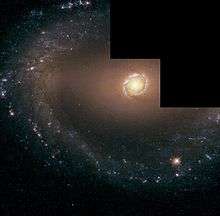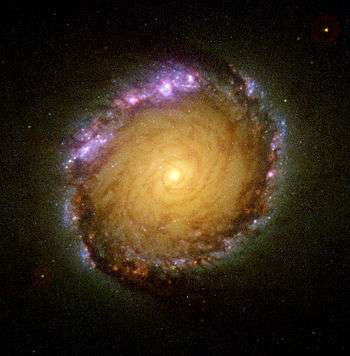NGC 1512
| NGC 1512 | |
|---|---|
|
| |
| Observation data (J2000 epoch) | |
| Constellation | Horologium |
| Right ascension | 04h 03m 54.3s[1] |
| Declination | −43° 20′ 56″[1] |
| Redshift | 898 ± 3 km/s[1] |
| Distance |
11.6 Mpc (38 Mly) h−1 0.73[2] |
| Apparent magnitude (V) | 11.1[1] |
| Characteristics | |
| Type | SB(r)ab[1] |
| Apparent size (V) | 8′.9 × 5′.6[1] |
| Other designations | |
| PGC 14391[1] | |
NGC 1512 is a barred spiral galaxy approximately 38 million light-years away from Earth[2] in the constellation Horologium. The galaxy displays a double ring structure, with one ring around the galactic nucleus and another further out in the main disk. NGC 1512 is a member of the Dorado Group.[3]
Gallery
 NGC 1512 and its companion the dwarf galaxy NGC 1510.[4]
NGC 1512 and its companion the dwarf galaxy NGC 1510.[4] An ultraviolet image of NGC 1510 and NGC 1512 taken with GALEX. The image shows that NGC 1512 has spiral arms that extend well beyond its optical disk. Credit:GALEX/NASA/JPL-Caltech.
An ultraviolet image of NGC 1510 and NGC 1512 taken with GALEX. The image shows that NGC 1512 has spiral arms that extend well beyond its optical disk. Credit:GALEX/NASA/JPL-Caltech. The galaxy seen by the Hubble Space Telescope.
The galaxy seen by the Hubble Space Telescope.
See also
References
- 1 2 3 4 5 6 7 "NASA/IPAC Extragalactic Database". Results for NGC 1512. Retrieved 2006-11-25.
- 1 2 "NASA/IPAC Extragalactic Database". Results for NGC 1512, Co-Moving Radial Distance. Retrieved 2014-12-18.
- ↑ Maia, M. A. G.; da Costa, L. N.; Latham, David W. (April 1989). "A catalog of southern groups of galaxies". Astrophysical Journal Supplement Series. 69: 809–829. Bibcode:1989ApJS...69..809M. doi:10.1086/191328.
- ↑ "Galactic David and Goliath". www.spacetelescope.org. Retrieved 27 July 2017.
External links
- NASA Astronomy Picture of the Day: A Panchromatic View (6 June 2001)
- SPACE.com: Baby Stars Clean House Quickly
This article is issued from
Wikipedia.
The text is licensed under Creative Commons - Attribution - Sharealike.
Additional terms may apply for the media files.
